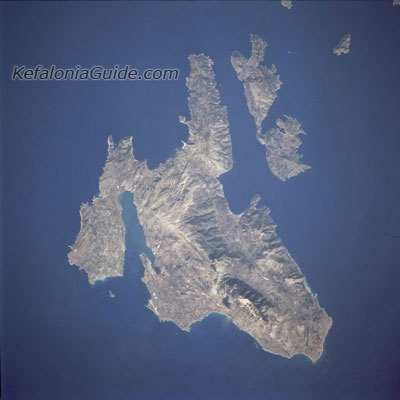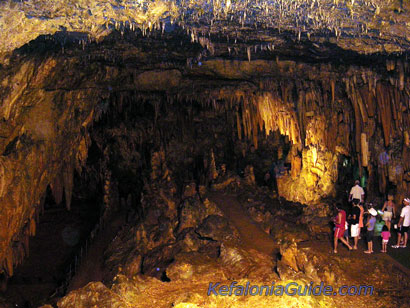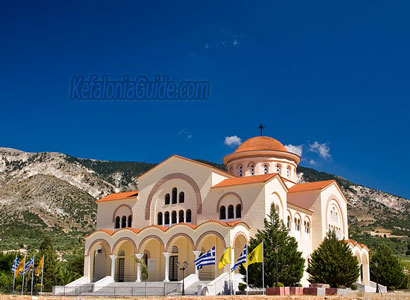 Kefalonia History
Kefalonia History
Welcome to
the Kefalonia Travel Guide.
It is a fully updated guide to all matters relating to this beautiful island Kefalonia in
the Ionian
Sea. Find information about the history of the island and about all the
areas of interest for the tourist
Kefalonia
History of Kefalonia
The island was named after the mythical Kefalos, son of Hermes and Ersi. Kefalos went into exile, after killing his wife by accident during a hunting trip. While in exile he met the king of Athens, Amfitryonas . Kefalos helped Amfitryonas with his war against Tafious and Tilevoes, residents of Kefalonia. After his victory Amfitryonas donated the island to Kefalos. Kefalos had 4 sons, Kranio, Palea, Pronniso and Sami, the four cities of Kefalonia where named after them, they were independent republics and produced their own currencies. The island was referred to, for this reason, as ‘Tetrapolis’, the four cities. Kefalos was of the same generation as Odysseus, king of Ithaca.  Kefalonia (Kefallinia or Cephalonia) is the largest and most mountainous island of the Ionian Islands. Located opposite the entrance to the Gulf Patraikos, north and south of the island of Lefkada. According to recent historical findings, it is thought that Kefalonia is, infact, the historical Ithaca, home of Homer, the great historian, whos work is the basis for many historians past and present. The island has an area of approximately 688 square kilometers and has approximately 27,651 residents. Much of the area is occupied by the main peaks of mount Ainos, Megas Soros (1.628m.) Agia Dinati(1.131m.) Eumorphia (1.043m.) and Kokini Rahi(1.078m.) The main valleys are those of Kranai and the Palikis peninsula.
Kefalonia (Kefallinia or Cephalonia) is the largest and most mountainous island of the Ionian Islands. Located opposite the entrance to the Gulf Patraikos, north and south of the island of Lefkada. According to recent historical findings, it is thought that Kefalonia is, infact, the historical Ithaca, home of Homer, the great historian, whos work is the basis for many historians past and present. The island has an area of approximately 688 square kilometers and has approximately 27,651 residents. Much of the area is occupied by the main peaks of mount Ainos, Megas Soros (1.628m.) Agia Dinati(1.131m.) Eumorphia (1.043m.) and Kokini Rahi(1.078m.) The main valleys are those of Kranai and the Palikis peninsula.
The coast of Kefalonia is formed by many bays and capes. The bigger bays are that of Sami, Myrtos, Argostoli, Lourdas and Livadi. Main capes are (starting from the south and moving to the east direction) Mounda, Kapros, Sarakiniko, Mitikas to the center, Dafnoudi in the north, Atheras in the northwest, Ortholithia and Gerogompos in the west, Akrotiri, Agia Pelagia, Liakos,and Kastanas in south. The coastline is generally rocky and steep in the Ionian and the formations are milder to the east side. 
 Of particular interest are the caves of the island, such as Melissani, which contains an underground lake, Agkalaki, St. Theodore, Zervati, Drogarati Caves, and Sakkos Cave . Mirtos beach to the northwest side of the island was voted 11 times as the best Greek beach according to the annual vote from the Hellenic Ministry for the Environment. It has been repeatedly described as the best beach of the Mediterranean and has been included in the list of most beautiful beaches on the planet. On the west side of the island in Paliki you can also visit the beautiful beach of Petanoi.
Of particular interest are the caves of the island, such as Melissani, which contains an underground lake, Agkalaki, St. Theodore, Zervati, Drogarati Caves, and Sakkos Cave . Mirtos beach to the northwest side of the island was voted 11 times as the best Greek beach according to the annual vote from the Hellenic Ministry for the Environment. It has been repeatedly described as the best beach of the Mediterranean and has been included in the list of most beautiful beaches on the planet. On the west side of the island in Paliki you can also visit the beautiful beach of Petanoi.
Several earthquake tremors hit the region every year. In 1953 a terrible earthquake reading 7.2 on the Richter scale almost destroyed the entire island, leaving only Fiskardo village, located north of the island virtually untouched and thus is the only village on the island that maintains the original architecture of the Ionion. There are various geological phenomena on the island such as the ‘island sinks’ located at Katavothres in Argostoli, the ‘rocking stone’ located at Kounopetra in Lixouri and the lakes of Avithos and Akoli in Pyrgi.
Almost every village name of Kefalonia ends with "-ata" such as Lourdata, Svoronata, Delaportata, Kaligata etc. It is thought that there are about 364 villages on Kefalonia. (Several of them are no longer inhabited). Also most of the villages are named after their original residents whose surnames ended with "-atos".
Due to the long occupation of the island by the Italians, most people speak good Italian and the Kefalonian dialect has many Italian words with some variations.  On the island there are many monasteries, some of which are inhabited by nuns.
On the island there are many monasteries, some of which are inhabited by nuns.
Some of the more famous monasteries include the Monastery of Saint Gerasimos, the Patron Saint of the island, the Monastery of Saint Andrew in the municipality of Livathos, the Monastery of St. Dionysios in Hionata, the Monastery Simotata in Sissi, the Monastery of the Virgin Mary in Markopoulo and the Monastery of Kipouraion in Lixouri .
The beautiful views of the Ionian sea can be admired from the west of the island, from Skala, up in the north in Fiskardo, from the Petanoi in Lixouri and from Sami to the east side of the island.
The famous archaeologist Spyridon Marinatos, known for his excavation work in Santorini, comes from the village of Kontogennadas (Kontogennada) in Paliki
Brief history
The cities and villages of the island were built on the hills, to escape the raids of pirates who pillaged the Ionian Sea around 1820. The Ionian Islands with the Treaty of Paris on 17th November 1815 were declared as "unified and an independent state", attached to Great Britain and managed by the British Commissioner.
In the years of the English occupation of the Ionian Islands (1815-1864) there was born in Kefalonia a radical movement. A movement inspired by the enlightenment and the ideals of the French Revolution. Bringing forward the principles of freedom, national independence, national sovereignty and social justice. The leaders of the movement were Ilias Zervos-Jacob and Joseph Momferatos. The movement was started on the island, but after the exile of the movement leaders to Zakynthos it spread to all of the Ionian Islands. A result of the movement lead to the unification of the Ionian Islands with Greece on 21st May 1864.
During the First World War the island was occupied for a short time by the French Naval Forces. Specifically, on 16th April 1916, in the Argostoli channel, the First and Second French Naval Squadron, made the decisions to take command of the Greek ports. On 11th April 1917 the French forces fired the Greek administration of Argostoli (including the then government leader Theodoros Gofas). In early April the French Second Light Squadron, namely S. A. Sarlie (CA Charlier), moved in inorder to take control of the channel of Corinth. On 21st April 1917 the French ended the blockade of the island.
In World War II, the island was conquered by the enemie forces. Until 1943 the occupying force was predominantly Italian, but there were also German forces, about 12,000 men. Confusion prevailed when the allied forces invaided and took control of Italy. The Italian soldiers expressed their desire to leave the island and return home, for them the war was over. The Germans feared that the Italian forces would be directed against them and would not let them leave the island. The Italians did not want to surrender their weapons to the Germans and eventually, the Italian and German forces were driven to a great battle, culminating in Argostoli. The Italians had the city under occupation for 6 hours, but eventually the Germans, who by then, occupied the whole island won. The 6,000 survivors of the 9,000 Italian soldiers were mercilessley executed by the Germans. Peace finally prevailed on the island in 1949.
Almost every home in Kefalonia was destroyed by the earthquake of 1953, causing many of the residents to flee the island.
The island became more famous the '90s thanks to the book written by Louis De Bernie, "Captain Corelli’s Mandolin” The book refers to a love story, which took place during the Second World War and is based on historical events. The book was made into a movie in 2001 and was filmed on site on Kefalonia, mostly in the town of Sami.
Sources of wealth
The high hills and mountains that are continuous on the island are perfect for the development of wind energy. In recent years the island has experienced great interest from investors for setting up wind farms. Currently an operational wind farm is already in place on Manolati-Xerolimpa in the Municipality of Argostoli, which supplies the national grid with 13,6 MW of electrical power. The island belongs to the interconnected national network of islands. Kefalonia is joining the future force requirements in the field of Renewable Energy in Kefalonia. The Prefecture of Kefallinia already has two wind farms in the construction phase, and 5 more in the permitting process.

Towns and villages of Cephalonia
Argostoli: 12,589 residents
Lixouri: 7,836 residents
Póros: 1,273 residents
Sami: 1,223 residents
Skala: 700 residents
Fiskardo: 447 residents
Assos: 122 residents
Personalities of the past
Mikelis Avlichos
Marinos Antypas
Nikos Kavadias
Andreas Laskaratos
Spyros Marinatos
Gerassimos Markoras
Ioannis Metaxas
Elias Miniatis
Andreas Michalitsianos
Nikolaos Platon
Ioannis Fokas
Nikos Fokas
Rokos Choidas
Panagis Vallianos
Vincent Damodos
Anthony Tritsi


















